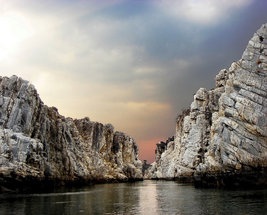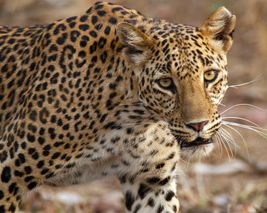Jabalpur: An Ode to a Queen
A city that hasn’t forgotten its roots and history, it has kept the alive the memory of its beloved queen Rani Durgavati. The historical city has been blessed with amazing natural phenomena; the enchanting marble rocks of Bhedaghat and the exhilarating Dhuandhar Falls. Spread across the Vindhyan ranges, the region has marvellous palaces and monuments to make it a memorable trip. An archaeologist’s dream, Jabalpur tourism has seen a rise and looks like it will continue to do so.
| Jabalpur Tourism: A Quick View of the City |
| State |
Madhya Pradesh |
| Official Language |
Hindi |
| Dial Code |
0761 |
| Population |
1,268,848 (as of 2011) |
| Currency |
Indian Rupee (INR) |
| Time Zone |
GMT +5:30 (IST) |
| Area |
412 metres |
Highlights: An Unforgotten Journey
Monuments & Museums
Out of all the places to visit in Jabalpur, the Madan Mahal fort ranks high up in the list. Situated on the top of a hill, the monument is a historical place of interest. Built by Gond rulers back in the 11th century AD, it is associated with Rani Durgavati as she fought against the Mughals on this site, but was actually built by the 37th Gond king Madan Verma. A local legend says that the fort harbours gold bricks and treasure from the times of the Gond dynasty and even has an underground tunnel as an escape route. And there is the Rana Durgavati Museum for the curiously inclined. Dedicated to the memory of Queen Durgavati, the museum houses a brilliant collection of sculptures, inscriptions and relics from prehistoric times. Located in the centre of the city, the museum is closed on Sundays, so make it a point to visit on a weekday.
Places of Worship
A little farther from the main city is the Chausat Yogini Temple which attracts believers and tourists alike. Literally translating to sixty-four ‘yoginis’, the temple has sixty-four statues encircling the temple along the inner boundary wall. Built in the 10th century, the shrine is considered to have some of the best carved stone figures belonging to the period of the Kalachuris. Legend has it that the ancient temple is connected to the Rani Durgavati Palace through an underground passage.
Nature Trails
Do not miss out on the wonderful Dumna Nature Reserve Park as you explore Jabalpur. Spread across an area of 1058 hectares, the park is home to exquisite flora and fauna. Here you will get a chance to witness chital, wild boar, porcupine, jackals and a variety of exotic birds. And then there are the enchanting Dhuandhar Falls. The name is a combination of the words Dhuan meaning smoke, and Dhar meaning flow, inspired by the smoky appearance of the gushing waterfall. Once you’re done with the Dhuandhar Falls which is at Bhedaghat, head to see the marble rocks that accompany the winding Narmada river.
Cuisine
Now that we have discussed Jabalpur’s famous places, let’s talk about another thing the city is famous for - its mouth-watering food. The cuisine in this city shows influences of the Mughals and the regions of Rajasthan and Gujarat. Most of its dishes have a rich, spicy or creamy flavour which includes the famous khopra pak, pilaf with peas and carrots, sabudana khichdi, malpua and rabdi. And if you’re looking for some street food, a day touring through Jabalpur’s street stalls will certainly not disappoint you. Try out these classic snacks, samosa, aloo banda, mangoda and bhajiya, when you explore the streets. And there is also the mouth-watering poha-jalebi which can only be savoured in the morning.
Interesting Facts about Jabalpur: Now you know
- It is generally accepted that the game of snooker originated in Jabalpur.
- The name of the city was formed by joining the Arabic word ‘Jabal’ (mountain) and the Sanskrit word ‘Pura’ (city).
- It is believed that Rana Durgavati built 85 ponds for water conservation out of which some are still remaining.
Location: The Centre of the Heart
Nestled in the Mahakaushal region of Central India, Jabalpur is at the centre of Madhya Pradesh. The administrative headquarters of the Jabalpur district, it has a major military base along with being a major education hub of India.
Click here to view Jabalpur on Google Map
Timings: Best Time to Visit
Tourism in Jabalpur is at its peak in the winters (October to February) with the temperatures ranging between 8 o C and 29 o C. Visiting in these months will make for a pleasant trip as you walk around exploring the city. Avoiding the city in the summers (March to May) is recommended as the temperatures can reach a high of 45 o C, and the heat of the rocky plains of Central India adds to the discomfort when stepping out. The rains (June to September) bring respite to the city with a prolonged monsoon, helping bring the temperature down. The national parks may be shut owing to the heavy showers, but it still makes for a lovely trip.
How to get to Jabalpur: The Way to History
By Air – The Jabalpur airport is 20 km away from the city centre and daily flights are available to New Delhi, Mumbai, Hyderabad, Kolkata and Ahmedabad.
By Rail – The Jabalpur Junction station has direct service to almost all the major cities.
By Road – The city is connected by road to the cities Varanasi, Nagpur, Bhopal, Jaipur, Raipur, Allahabad, Hyderabad, Bilaspur and Bangalore. The country’s longest highway National Highway 7 runs through the city and National Highway 12 originates in Jabalpur.
History: Remnants of a Forgotten Time
The land of Jabalpur has been under diverse rulers. Ashokan relics dating back to 300 BCE have been found near the city which show the presence of the Mauryan Empire. After the fall of the empire, Jabalpur became a city state till it fell under the Satavahana dynasty. It also served as a vassal state of the Gupta Empire for some time before becoming the capital of the Kalachuri dynasty. Then the city became the Gondwana kingdom and it was during this time that Rani Durgavati died fighting the Mughals, an incident that occurred during Emperor Akbar’s expansion rule. This was followed by the Marathas conquering the Nizam rule. And after the spread of the British Raj, Jabalpur also came under their rule till India attained Independence in 1947.
With so much awaiting in this beautiful city, Jabalpur tourism has only one way to go and that is forward.

























